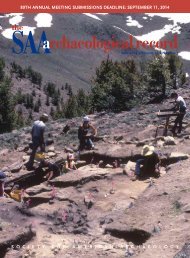SAA
Nov2016_web
Nov2016_web
Create successful ePaper yourself
Turn your PDF publications into a flip-book with our unique Google optimized e-Paper software.
82ND ANNUAL MEETING<br />
Dr. Bruce G. Miller (UBC). c̓əsnaʔəm, known to archaeologists<br />
variously as the Eburne Midden, Great Fraser Midden, and Marpole<br />
Midden, recently made headlines when ancient burials<br />
were uncovered through urban development and the<br />
Musqueam strove to protect them. This collaborative exhibit<br />
project was developed to generate public discussions about heritage<br />
and indigenous history and to raise awareness of the significance<br />
of c̓əsnaʔəm for the Musqueam people and for<br />
Vancouver. The exhibition reexamines the historical collection<br />
and display practices of the museum itself within the context of<br />
colonial history, and the tour presents a rare opportunity to consider<br />
this effort in conversation with two of its leading scholars.<br />
The urban landscape has not fully obscured the indigenous or<br />
archaeological past. Our second tour is a bus tour led by<br />
Dr. Rudy Reimer/Yumks (SFU/Squamish). This tour will visit<br />
three to four important indigenous places within what is now<br />
known as Stanley Park. Prior to and through the contact period<br />
with Europeans and other settlers, this area was central to First<br />
Nations cultures. It was well settled and used in a variety of<br />
ways. This tour will make stops at archaeological sites, traditional<br />
use areas, and places integral to Coast Salish belief. The opportunity<br />
to join Rudy as he navigates through archaeological, historical,<br />
urban, and spiritual landscapes is not to be missed. Be<br />
prepared to walk, rain or shine. Snacks recommended, water is<br />
provided.<br />
Our third tour is to UBC’s Museum of Anthropology (MOA)<br />
and Laboratory of Archaeology (LOA). Both institutions are dedicated<br />
to world arts and cultures, and both have a special emphasis<br />
on First Nations of British Columbia. This tour has two<br />
variants. In the first, the focus will be on fiber and textiles. This<br />
tour, co-sponsored by the <strong>SAA</strong> Fiber Perishables Interest Group<br />
(but open to all <strong>SAA</strong> members), will be led by MOA conservator<br />
Heidi Sweiringa. It will include behind-the-scenes exploration<br />
of wet-site basketry and Peruvian textiles. The second variant<br />
will be led by Dr. Sue Rowley (UBC) and focus on the recently<br />
renovated research facilities and exhibits of LOA and MOA and<br />
the long history of engagement between these institutions and<br />
First Nations. Both tours will provide an opportunity to visit<br />
MOA’s exhibits including Layers of Influence: Unfolding Cloth<br />
Across Cultures, a cross-cultural display of clothing from MOA’s<br />
worldwide collections curated by Dr. Jennifer Kramer (UBC),<br />
MOA’s curator of the Pacific Northwest. Note that registrants<br />
for the annual meeting receive discounted rates to both the<br />
Museum of Vancouver ($9) and the Museum of Anthropology<br />
($16) anytime during the conference.<br />
In academic settings around Vancouver it has become somewhat<br />
rote to start any proceeding with the acknowledgment that<br />
we gather on traditional and unceded indigenous territory; the<br />
<strong>SAA</strong> is no exception, and its opening session will include First<br />
Nations representation. I suggest we consider more fully what<br />
is at stake in this declaration. The identification of an indigenous<br />
territory is an acknowledgment that colonization has<br />
usurped land and other rights, and I would argue that reconciliation<br />
in these terms remains unresolved. An invocation of the<br />
traditional nature of these claims reminds us that the legal and<br />
cultural arena in which reconciliation is to be effected includes<br />
and perhaps shifts to the legal systems of the indigenous communities.<br />
Thus aspirations of neutrality and objectivity in nonnative<br />
courts and governance mask a double standard that<br />
perpetuates colonial asymmetries (Martindale 2014). Third, the<br />
acknowledgment itself asks guests to be respectful of our hosts,<br />
including recognition that the world we are in is not simply the<br />
world as we perceive it (Martindale and Nicholas 2014).<br />
Thus, this now-standard acknowledgment toward indigenous<br />
hosts should be more than a gesture; it is implicitly a request to<br />
make the world a better place. This activism extends beyond<br />
how we act and includes challenges to how we understand.<br />
Archaeology is not simply a practice, but a way of knowing. For<br />
example, I work with Penelakut elder Jillian Harris using<br />
archaeology to identify the graves of children who died at the<br />
Kuper Island Indian Residential School on the Gulf Islands to<br />
the west of Vancouver, a government-sponsored institution that<br />
operated for almost a century and had the highest child mortality<br />
rate of any residential school in Canada. Though we look for<br />
unmarked graves, Jillian argues that our task is really an exploration<br />
of spiritual trauma across a sentient landscape (Harris et<br />
al. 2016). I cannot see and do not understand what this means,<br />
but I am unwilling to argue that her perception is wrong.<br />
Rather, I try to respect what she sees as we work together.<br />
Those of us who embrace the challenge of exploring other peoples’<br />
histories through archaeology are well aware of the situatedness<br />
of knowledge, even as we strive for objectivity, verifiability,<br />
and reproducibility of our results. The landscapes of Vancouver<br />
are numerous, and visitors for the meeting will find their own<br />
path and make their own history here. There is value in remembering<br />
that we are neither the first nor the only ones to travel<br />
these lands.<br />
References Cited<br />
Bodley, John H.<br />
2012 Anthropology and Contemporary Human Problems. 6th ed.<br />
Altamira, Lanham, Maryland.<br />
Carlson, Keith Thor (editor)<br />
2001 A Stó:lo-Coast Salish Historical Atlas. University of Washington<br />
Press, Seattle.<br />
>VANCOUVER, continued on page 43<br />
8 The <strong>SAA</strong> Archaeological Record • November 2016




